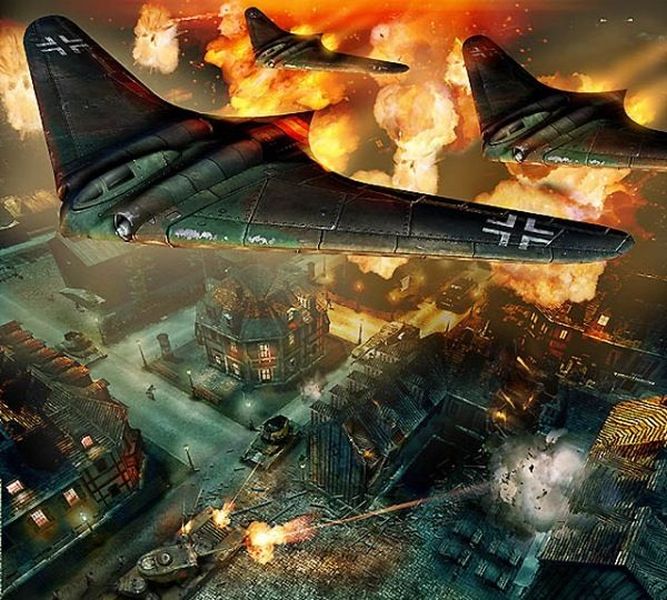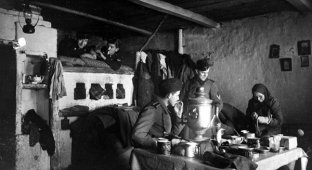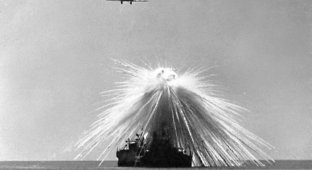Incredible military developments of Nazi Germany... (14 photos)
The greatest technological progress can be observed during armed conflicts. The additional motivation to win, as well as research in some areas, provides extraordinary progress that might take decades to achieve in peacetime. The Second World War was no exception. Some of the most famous successes, such as the Russian and American space projects in the 60s, arose with the beginning of German exploration during World War II.

Most of us have already watched programs about the secret weapons of the Nazi regime, which, if used at another time, could turn the tide and change the outcome of the Second World War. Previously, Germany considered itself a nation superior to others in scientific development, and made considerable strides in military technology used in the early stages of the conflict. Then Hitler - perhaps believing that he had already won the war - began to place little emphasis on military development during the war. And for some periods this was decisive. When the situation changed, Germany returned to the search for high-tech weapons, which was a desperate attempt to return to the previous state of affairs. This extraordinary weapon, or "wunderwaffe", arrived too late on the war scene - but what would have happened if it had come earlier?
WunderWaffe 1 – Vampire Vision

The Sturmgewehr 44 was the first assault rifle, similar to the modern M-16 and Kalashnikov AK-47. Snipers could use the ZG 1229, also known as the "Vampire Code", also in night conditions, due to its infrared night vision device. It was used during the last months of the war.
WunderWaffe 2 – Super Heavy Tank

German engineers worked on many designs for super-heavy tanks. The Panzerkampfwagen VIII Maus was the heaviest model to be prototyped during the war. This tank weighed about 180 tons.
The Bear version, weighing 1,500 tons, carried 2,800 mm cannons, as well as 2,150 mm additional rotating turrets located at the rear. To propel this giant, 4 diesel engines from German submarines were required.

WunderWaffe 3 – The world's first cruise missile

The V-1 was powered by a turbojet engine. Its launches began immediately after June 13, 1944, the day the Allied forces landed in Europe.

The V-2, the successor to the V-1, was the first man-made object to fly into suborbital space. At 4,000 km/h, the V-2 was impossible to intercept; she could also reach her target at speeds exceeding the speed of sound.
V-2 missiles were too advanced for their time, making them expensive compared to the destructive power of their small conventional warheads. They were launched from mobile launch complexes; when used against civilians, they spread fear and panic among the people of London.

Approximately 3,000 V-2 missiles were fired at Allied positions, killing approximately 7,000 civilians* and military personnel; they were stopped being launched only when Reich forces were forced to retreat beyond the range of these weapons. If German forces had had more time, the course of the war would have been completely different, since their military program included nuclear warheads (in development), or chemical and biological options that were never used.
*In reality, Nazi ICBMs were more of a psychological weapon, since the combat effectiveness compared to the costs was extremely low
WunderWaffe 5 – Turbojet aircraft

The applicability of a turbojet engine to a military aircraft was also one of the trends that ran like a red thread through the German military machine. Engineers developed a model and prototype. They also created the conditions for this aircraft to enter service before the end of the war. But the number of these vehicles was not sufficient to change the course of the conflict in favor of Germany. The Messerschmitt Me 262 was amazingly advanced - but it was not intensively refined for combat use. However, despite this, Me262 won more than 500 victories. 100 German planes were shot down.

The Ta-183 was designed to be the successor to the Me-262. At the end of the war it was tested in wind tunnels. It is interesting to note that a few years later the Soviet Union developed a multi-purpose combat fighter aircraft, the stunning MIG-15, whose similarities to the German prototype are obvious - although this information was denied by the Soviet regime.

Ta-183, German prototype

MiG-15, Mikoyan-Gurevich design bureau
WunderWaffe 6 – Suborbital Bomber

"Silbervogel", or "Silver Bird" is the name of a tactical suborbital bomber propelled by rockets. It was tested in wind tunnels, but no prototype was ever produced. However, this is a big step forward in engineering prowess and vision for the future. This is how a whole direction of spacecraft was predicted, such as the reusable spacecraft Space Shuttle. German scientists believed that the Silver Bird, with a load of 4000 kg, would be able to cross the Atlantic Ocean and reach the American continent. The flight was supposed to take place non-stop, landing in the Pacific Ocean on Japanese territory.

WunderWaffe 7 – Flying Wing

A flying wing is a spacecraft with a fixed wing geometry and no fuselage. All equipment and crew were housed inside the main wing structure. In theory, the "wing" is the most efficient aircraft in terms of aerodynamics and structural weight, mainly due to the absence of any external components, but also due to the lifting force of the structure. However, as was later proven, the complexity and cost of such a configuration are enormous, which reduces its practical applicability for modern civil aeronautics. Horten H1 made its first flight in 1944. After the war, many prototypes existed based on German research.
Many other fantastic weapons - a modern helicopter, a solar cannon (which could focus the sun's rays to melt planes), whirlpool machines (designed to create artificial tornadoes), or air cannons (which could create atmospheric conditions unacceptable to Allied aircraft) - were manufactured and tested for military purposes























